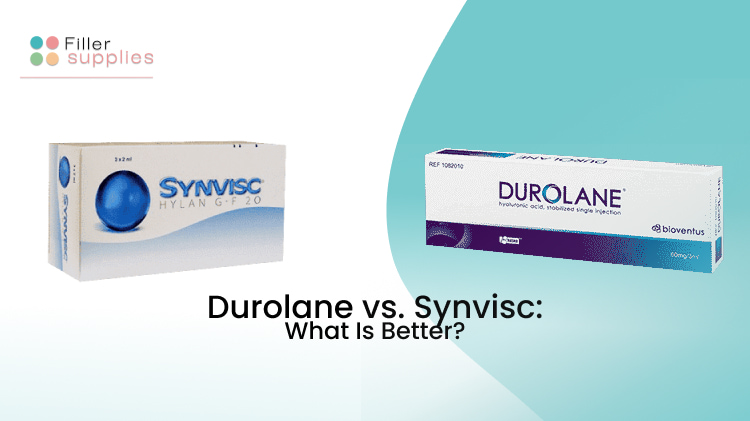Durolane vs. Synvisc: What Is Better?

Osteoarthritis is a chronic disease that causes much discomfort in joints. Despite the fact that it cannot be fully cured as of now, its symptoms might be substantially suppressed by a variety of methods, starting from physical therapy and ending with knee replacement surgery.
Hyaluronic acid injections belong to the most beloved methods of reducing pain in joints in patients with osteoarthritis. Their minimal invasiveness, safety, and effectiveness have already won the hearts of healthcare providers and their patients worldwide. Durolane and Synvisc are quite popular medications in this regard.
But what is better, a Durolane injection vs. Synvisc injection? Let us figure it out together right away!
General Information on Durolane and Synvisc
The below-mentioned text features general information on Durolane and Synvisc. Let us discuss their manufacturers, composition, and indications.
Durolane
Durolane is a brand of orthopedic injections used to reduce joint pain in patients with osteoarthritis. Its mottoes sound like “say no to limits,” “do what you love,” and “keep moving.” They reflect the main mission of Durolane pretty well, – the brand aims to return joint mobility to osteoarthritic patients in an easy, secure, and productive way.
Durolane’s product line includes two solutions that differ in volume, namely the basic 3ml version of Durolane and the 1ml version of Durolane SJ. In most cases, healthcare providers prescribe Durolane (3ml) for knee osteoarthritis management and Durolane SJ (1ml) for ankle, elbow, wrist, finger, or toe osteoarthritis management (as a single injection).
Durolane usually provides patients with a significant reduction of pain in joints for a time period that equals six months (unless prolonged by further Durolane injections).
| Feature | Durolane | Synvisc |
|---|---|---|
| Active Ingredient | Hyaluronic Acid (Non-Animal Stabilized) | Hylan G-F 20 (Cross-linked Hyaluronic Acid) |
| Indication | Osteoarthritis of the knee | Osteoarthritis of the knee, hip, ankle, shoulder |
| Number of Injections | Single injection | One injection (Synvisc-One) or three injections (Synvisc) |
| Duration of Effect | Up to 6 months | Up to 6 months (Synvisc-One) or longer for 3-injection Synvisc |
| Mechanism of Action | Acts as a lubricant and shock absorber in the joint | Acts as a lubricant and shock absorber in the joint |
| FDA Approval | Approved in 2001 | Approved in 1997 |
| Injection Site Reactions | Pain, swelling, or discomfort at the injection site | Swelling, pain, heat, redness at injection site |
| Origin of Hyaluronic Acid | Non-animal (biotechnology-produced) | Derived from chicken combs |
| Cost | Typically higher than Synvisc | Generally more affordable than Durolane |
| Storage | Room temperature | Refrigeration required |
Manufacturer
The manufacturer of Durolane is Bioventus. It is a global pharmaceutical corporation that produces ortho-biological products, such as restorative therapies, pain-management treatments, and surgical solutions. Apart from Durolane, Bioventus also distributes Supartz FX and Gelsyn-3 to manage osteoarthritis-related symptoms.
Composition
The composition of Durolane has a synthetic nature. It is based on highly purified hyaluronic acid of non-animal origin and a high molecular weight that effectively substitutes naturally occurring hyaluronic acid that might be found in human joints. Other components in the composition of Durolane are sodium chloride, disodium hydrogen phosphate dihydrate, and potassium dihydrogen phosphate.
Curious about the differences between Evenity and Prolia? Discover the answer on Fillersupplies.com. Dive into this informative article that explores the comparison between these two popular osteoporosis medications. Uncover their unique features, benefits, and potential considerations to make an informed decision for your bone health. Whether you’re looking for effective treatments to strengthen your bones and prevent fractures, this comprehensive guide provides valuable insights. Visit Fillersupplies.com now to explore the Evenity vs. Prolia comparison and make informed decisions for your well-being.
Indications
The main indication of Durolane is to reduce knee pain associated with knee osteoarthritis. However, it might also be used to diminish hip, ankle, elbow, shoulder, finger, and toe pain in patients with the disease. It is essential to mention that Durolane is usually prescribed if a patient tried non-invasive methods of treating osteoarthritis-related joint pain but achieved no results.
P.S.
Only a licensed healthcare provider is eligible to order Durolane online and administer it in a form of an intra-articular injection.
Synvisc
Synvisc, in its turn, is a trademark for orthopedic injections applied for the reduction of joint pain associated with osteoarthritis. It helps patients substantially minimize their pain scores in joints and, therefore, return to an active lifestyle in an effortless, safe, and highly effective way.
The two main products in the Synvisc product line are Synvisc and Synvisc One. The basic difference between them is in their volume. The basic Synvisc is a 2ml injection that should be administered once a week every three weeks. While Synvisc One, in its turn, is a single 6ml injection.
On average, Synvisc intra-articular injections provide patients with long-lasting results that equal six months and might be prolonged by repeated courses that involve the product.
Manufacturer
Sanofi is a global pharmaceutical corporation that manufactures Synvisc. It combines experience and innovation to produce high-quality aesthetic medicine solutions, such as Adlyxin, Allegra, Apidra, Dupixent, Ranexa, and so on. Still, Synvisc is the main osteoarthritis-related product in the Sanofi line.
Composition
The composition of Synvisc is based on hylan-polymers (a type of hyaluronic acid that might be found in chicken combs) with a high molecular weight. They efficiently make up for the deficiency of naturally occurring hyaluronic acid that is stored in human joints. Apart from hylan-polymers, the composition of Synvisc also contains sodium chlorides (these substances help hylan-polymers to replace the synovial fluid of a human joint.
Indications
Under normal circumstances, Synvisc should be used to treat pain in the knee joint in patients with osteoarthritis. At the same time, it might also be injected to manage pain in the hip, ankle, elbow, shoulder, finger, and toe joints. The medication has to be injected if a patient didn’t respond appropriately to other non-invasive treatments of osteoarthritis-related pain in joints.
P.S.
Synvisc belongs to products intended for professional use. Similar to other HA injections, it should be administered by a licensed healthcare provider, who is eligible to purchase Synvisc online.
A Comparison of Synvisc vs. Durolane
Now, let us compare and contrast Synvisc and Durolane. Below, you will find the list of key similarities and differences between these products.
Explore a comprehensive guide to Monovisc side effects at Filler Supplies. Our detailed blog post provides essential information about this hyaluronic acid-based dermal filler. Discover the potential side effects of Monovisc and gain valuable insights into their occurrence, duration, and management. Understand the importance of proper administration and post-treatment care to minimize any adverse reactions. With our in-depth analysis, you can make an informed decision and have a better understanding of Monovisc’s safety profile. Visit Filler Supplies’ blog for an extensive guide on Monovisc side effects and ensure a safe and satisfying dermal filler experience.
Similarities
Synvisc and Durolane are intra-articular hyaluronic acid injections used for joint pain reduction in patients with osteoarthritis. They belong to the most popular medications in this regard. Here is the list of main similarities between Synvisc and Durolane:
- They belong to medications designed to reduce pain scores associated with knee osteoarthritis (also known as knee OA);
- They should be used if a patient hasn’t responded adequately to non-invasive methods of the reduction of pain in joints after a doctor diagnosed arthritis;
- They might be used to diminish pain scores connected to hip, ankle, elbow, shoulder, finger, and toe osteoarthritis;
- They are based on hyaluronic acid (HA) of the highest molecular weight (unlike a great number of other osteoarthritis-related treatment options of low molecular weight HA);
- They function as a lubricant and shock absorber for a joint affected by osteoarthritis;
- They should be administered by a certified healthcare provider in a form of an intra-articular sodium hyaluronate injection;
- They provide patients with significant improvements in the level of comfort in synovial joints (according to recent randomized controlled trials, more than 90% of patients experience substantial relief of pain in joints after undergoing a Durolane or Synvisc injection);
- They create long-lasting results that equal six months;
- They have a low risk of any serious side effects (except temporary joint stiffness, muscle pain, or nausea).
Differences
Despite all their similarities, Durolane and Synvisc are not identical. Here is the list of main differences between them:
- Durolane is based on synthetic hyaluronic acid of non-animal origin. Synvisc, in its turn, includes naturally-occurring hyaluronic acid that might be found in chicken combs (known as hylan-polymers);
- Fewer injections of Durolane are usually required to create a significant reduction of pain in joints (if compared to multiple injections of Synvisc). More precisely, Durolane is a one-injection treatment, while Synvisc is a medication that might be administered in three to five injections. Still, a healthcare provider might suggest alternative dosing regimens based on the individual peculiarities of each patient;
- The primary outcome of Durolane is a little bit greater reduction of knee pain (if compared to Synvisc). In other words, it leads to a slightly greater reduction of pain in the knee. Still, both treatments are exceptionally effective.
A Verdict
All in all, Durolane and Synvisc belong to exceptionally safe, effective, and long-lasting methods of pain relief in patients with osteoarthritis. They both return joint mobility in a minimally-invasive way. Therefore, it is only up to you and your healthcare provider to define which product, Durolane or Synvisc, will do the best job in your individual case. For instance, Durolane might be a better option for a patient who is allergic to eggs or chicken meat. And vice versa, Synvisc might become a way out for a patient who does not respond adequately to synthetic hyaluronic acid.
So, how about relying on your healthcare provider and taking care of your osteoarthritis-related pain in joints?


